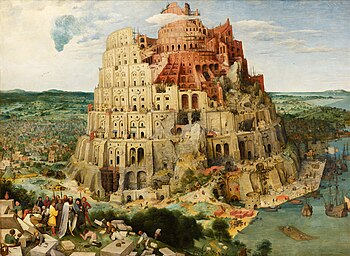
Back برج بابل (لوحة) Arabic Babil qülləsi (rəsm) Azerbaijani Вавілонская вежа (Пітэр Брэйгель) Byelorussian Tour Babel (Brueghel) Breton La torre de Babel (Brueghel) Catalan Turmbau zu Babel (Bruegel) German Ο Πύργος της Βαβέλ (Μπρίγκελ) Greek La torre de Babel (Brueghel) Spanish Babelgo dorrea (Bruegelen margolana) Basque برج بابل (بروگل) Persian
| The (Great) Tower of Babel | |
|---|---|
 | |
| Artist | Pieter Bruegel the Elder |
| Year | c. 1563 |
| Medium | oil on wood panel |
| Dimensions | 114 cm × 155 cm (45 in × 61 in) |
| Location | Kunsthistorisches Museum, Vienna |
| The (Little) Tower of Babel | |
|---|---|
 | |
| Artist | Pieter Bruegel the Elder |
| Year | c. 1563 |
| Medium | oil on wood panel |
| Dimensions | 60 cm × 74.5 cm (24 in × 29.3 in) |
| Location | Museum Boijmans Van Beuningen, Rotterdam |
The Tower of Babel was the subject of three paintings by Dutch and Flemish Renaissance painter Pieter Bruegel the Elder. The first, a miniature painted on ivory, was painted in 1552–1553 while Bruegel was in Rome, and is now lost.[1][2] The two surviving works are oil paintings on wood panels, sometimes distinguished by the prefix "Great" and "Little" and by their present location: Kunsthistorisches Museum Wien in Vienna and the latter in the Museum Boijmans Van Beuningen in Rotterdam. The Tower of Babel in Vienna is dated 1563, while the version is Rotterdam is undated but widely believed to have been painted sometime after.[3]
The paintings depict the construction of the Tower of Babel, which, according to the Book of Genesis in the Bible, was built by a unified, monolingual humanity as a mark of their achievement and to prevent their dispersion: "Then they said, 'Come, let us build ourselves a city, and a tower with its top in the heavens, and let us make a name for ourselves; otherwise we shall be scattered abroad upon the face of the whole earth.'"[4] God punishes the builders for their vanity by "confusing their speech" into different languages so that they could no longer communicate; however, in both paintings, Bruegel focuses on the construction of the tower rather than the biblical story as a whole.[5]
The (Little) Tower of Babel in Rotterdam is about half the size of The (Great) Tower of Babel in Vienna, although the tower in Rotterdam is 250% bigger than the one in Vienna. The two paintings share exactly the same composition—and modern X-rays reveal that the Tower in Rotterdam initially resembled the one in Vienna—but differ greatly in specific details, including the architectural style of the towers, the color palette and hues, and the viewpoint.[3] Most notably, the Vienna version has a group in the foreground, with the main figure presumably Nimrod, who was believed in some Christian traditions to have ordered the construction of the tower.[6]
Bruegel's composition of the Tower of Babel, particularly in the Vienna version, is considered the most famous and widely emulated depiction;[7] both paintings are regarded as among his best works,[3] and are considered exemplars of his characteristically painstaking and "encyclopedic" attention to detail.[3][7]
- ^ Orenstein, 6, one of the works belonging to Giulio Clovio
- ^ Morra, Joanne (2007). "Utopia Lost: Allegory, Ruins and Pieter Bruegel's Towers of Babel". Art History. 30 (2): 200. doi:10.1111/j.1467-8365.2007.00538.x.
- ^ a b c d "The Tower of Babel". www.bruegel2018.at. Retrieved 2024-09-16.
- ^ Genesis 11:4.
- ^ "The Tower of Babel". Google Arts & Culture. Retrieved 2024-09-16.
- ^ Cite error: The named reference
Art and the Biblewas invoked but never defined (see the help page). - ^ a b "The Tower of Babel". www.khm.at. Retrieved 2024-09-16.